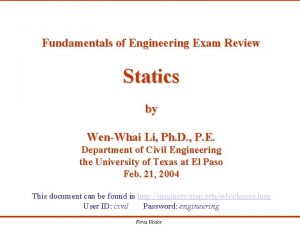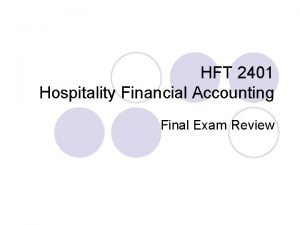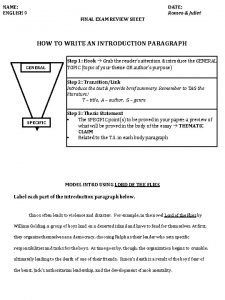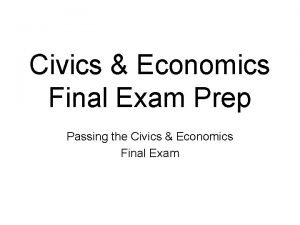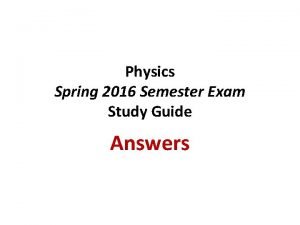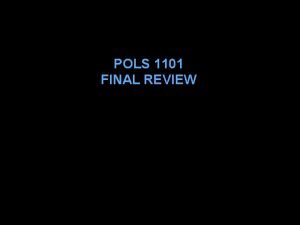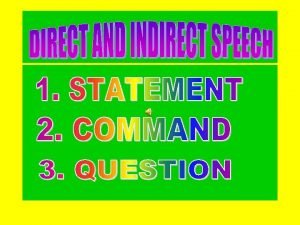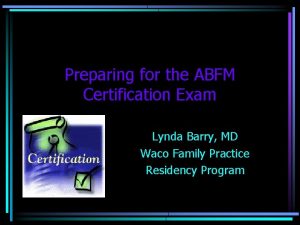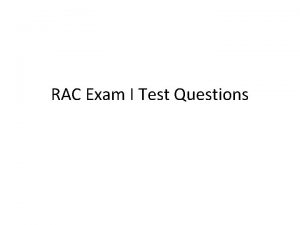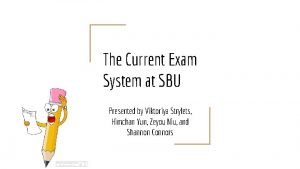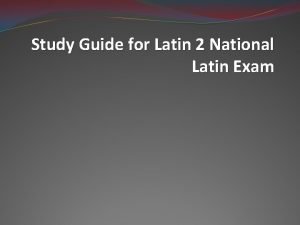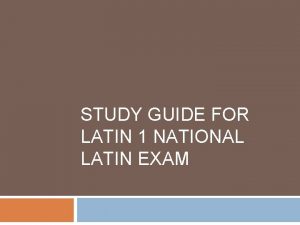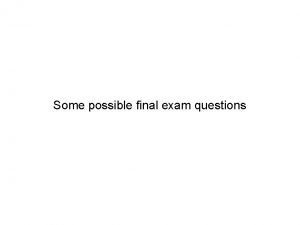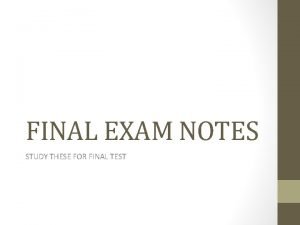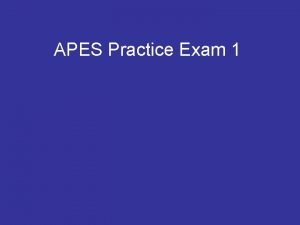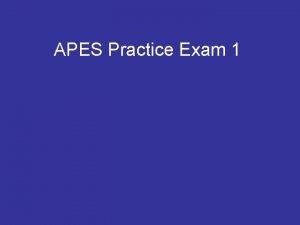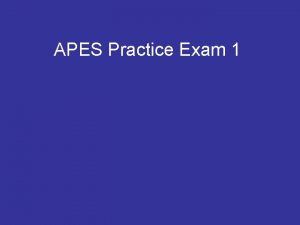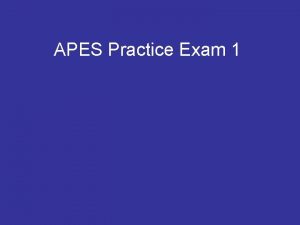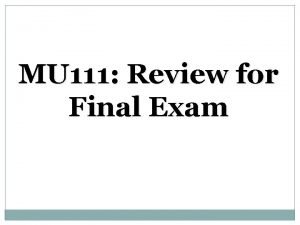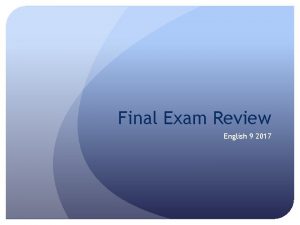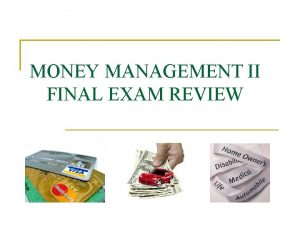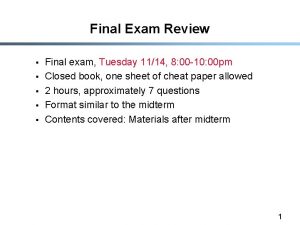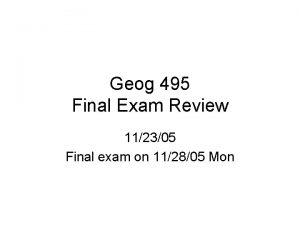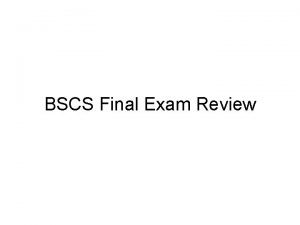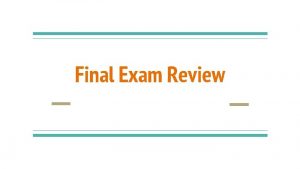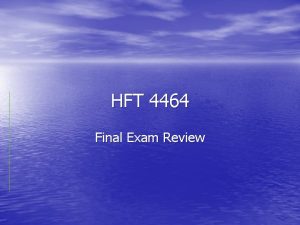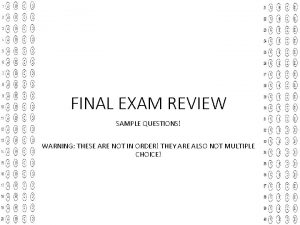Final Exam Review Study these practice questions for















































- Slides: 47

Final Exam Review Study these practice questions for your exam!!

A chemical bond resulting from an attraction between a cation and an anion is called…. A. Covalent bond B. Ionic bond C. Organic bond D. Acidic bond

VSEPR explains A. Octet rule. B. Metallic bonding. C. Shapes of molecules. D. Traits of metals.

What type of bond involves sharing electrons? A. Covalent bond B. Ionic bond C. Organic bond D. Acidic bond

What is the overall charge of any compound? A. positive B. negative C. neutral

Which molecule is tetrahedral? A. CH 4 B. H 2 O C. CO 2 D. SO 3

Which is an acid? A. HI B. C 9 H 20 C. Cs. CN D. SO 3

How many valence electrons does aluminum have? A. 3 B. 13 C. 26. 98 D. 41

What is the charge of lithium ion? A. +1 B. -1 C. +3 D. -3

Which element is oxidized in the following reaction? 2 HCl + Zn Zn. Cl 2 + H 2 A. Hydrogen B. Zinc C. Zinc chloride D. Chloride

Molar mass is calculated from A. an experiment. B. the coefficients of an equation. C. the formula and periodic table.

Actual yield is determined by A. experimentation. B. guessing. C. calculations. D. math formulas.

What is the p. H of a neutral solution? A. 0 B. 1 C. 7 D. 14

What is the empirical formula of P 4 O 10? A. P 4 O 10 B. P 8 O 20 C. P 3 O 5 D. P 2 O 5

Sodas have a p. H of 4. They are A. Acidic. B. Basic. C. Neutral.

What is the element symbol for sodium? A. So B. S C. N D. Na

What is the molar mass of calcium? A. 20. 0 g/mol B. 40. 08 g/mol C. 12. 01 g/mol D. 2 g/mol

What is the universal solvent? A. salt B. oxygen C. water D. molarity

How many shared pairs of electrons are in the diagram? A. 3 B. 2 C. 6 D. 5

Acids react with bases to produce… A. Water and hydrogen gas B. Bases and acids. C. Salt and water D. Calcium

Which of the following is a noble gas? A. Neon B. Hydrogen C. Titanium D. Calcium

Sugar water is a(n) A. electrolyte. B. non-electrolyte.

Salt water is a(n) A. electrolyte. B. non-electrolyte.

Acids taste… A. Sour. B. Bitter. C. Sweet. D. Salty.

Which diagram represents water vapor?

What can be added to a solution to make the solute dissolve easier? A. heat B. ice cubes C. more solute D. more water

The table shows the specific heat capacity of four substances. Substances Sp. Ht Cap (J/g 0 C) Aluminum 0. 900 Glass 0. 500 Carbon dioxide 0. 843 Water 4. 18 Whish substance will require the least amount of energy to raise its temperature? A. B. C. D. Aluminum Glass Carbon dioxide Water

A process is endothermic if… A. The temperature increases. B. The temperature decreases. C. The solution turns red. D. The solution turns blue.

What is the empirical formula? A. CH 2 B. CH 3 C. C 5 H 10 D. C 4 H 10

What are the products of the reaction? Na. OH + H 3 PO 4 __? __ + __? __ A. Sodium hydroxide and hydrogen phosphate B. Phosphoric acid and water C. Sodium phosphate and water D. Sodium and phosphorus.

When the following equation is balanced, what is the coefficient of aluminum phosphate, Al. PO 4? __ Al(NO 3)3 + __ Ca 3(PO 4)2 __ Al. PO 4 + __ Ca(NO 3)2 A. B. C. D. 1 2 3 4

What does the (s) stand for in chemical equation? A. insoluble (solid) B. soluble (aqueous) C. dissolved in water D. gas

What type of reaction is 2 Ca(OH)2(s) + 2 HCl(aq) Ca. Cl 2 (aq) + H 2 O(l) A. Acid-base B. Precipitation C. Redox

What type of reaction occurs between sulfuric acid and silver nitrate? A. Acid-base B. Precipitation C. Redox

What is the formula for carbon monoxide? A. CO B. CO 2 C. C 2 O 2 D. Ca. O

What is the formula for lithium oxide? A. Li. O B. Li 2 O C. Li. O 2 D. Li 2 O 2

If temperature increases, volume A. Increases. B. Decreases.

What is the standard volume of any gas at STP? A. 11. 2 L B. 1. 0 L C. 5. 0 L D. 22. 4 L

What would happen to a balloon placed in the freezer? A. The volume would increase. B. The volume would decrease. C. The volume remains constant. D. It depends on the gas inside the balloon.

What is the name of Zn. Cl 2? A. Zinc chloride B. Zinc (II) chloride C. Zinc (II) chloride (II) D. Zinc dichloride

How many moles of H 2 are produced when 4. 0 moles of sodium reacts? 2 Na + 2 H 2 O 2 Na. OH + H 2 A. B. C. D. 1. 0 moles 2. 0 moles 4. 0 moles 8. 0 moles

What is the p. H of a solution with a p. OH of 9? A. 9 B. 4 C. 5 D. 14

A mole is… A. 6. 02 x 1023 B. 6. 02 C. 12. 01 D. 14

The volume of a gas is 5. 0 L. If the temperature is increased from 5. 0 C to 10. 0 C, what is the new volume? A. 2. 5 L B. 5. 1 L C. 10. L D. 20. L

What happens to volume of a gas during compression? A. increases B. decreases C. remains constant

Boiling point, freezing point, surface tension, density, and compressibility are… A. Physical changes B. Chemical changes C. Physical and chemical changes

If H is negative, the reaction is A. Endothermic. B. Exothermic.
 Uncontrollable spending ap gov
Uncontrollable spending ap gov World history spring final exam review answers
World history spring final exam review answers Spanish 1 semester 1 final exam answer key
Spanish 1 semester 1 final exam answer key Human body systems final exam
Human body systems final exam Poe practice test answer key
Poe practice test answer key Ied final exam
Ied final exam World history semester 2 review
World history semester 2 review Entrepreneurship 1 final exam review
Entrepreneurship 1 final exam review Spanish 2 final exam review packet
Spanish 2 final exam review packet Earth science final exam review
Earth science final exam review Ap world history final exam
Ap world history final exam American history semester 2 final exam
American history semester 2 final exam English semester 2 final exam
English semester 2 final exam Physics 20 final exam practice
Physics 20 final exam practice Noah carried a skateboard
Noah carried a skateboard Mat1033c
Mat1033c Fe exam statics review
Fe exam statics review Zoology final exam review
Zoology final exam review Earth science final exam
Earth science final exam Algebra 1 final review packet
Algebra 1 final review packet Hft 2401 exam 1
Hft 2401 exam 1 Personal finance final exam review
Personal finance final exam review Spanish 1 final review
Spanish 1 final review Psyc 1504 final exam
Psyc 1504 final exam Hbs eoc review
Hbs eoc review Abc final exam practice test
Abc final exam practice test World history and geography final exam study guide
World history and geography final exam study guide Fall semester exam review us history
Fall semester exam review us history Romeo and juliet exam review
Romeo and juliet exam review Civics and economics final exam study guide
Civics and economics final exam study guide Physics semester 1 final exam study guide answers
Physics semester 1 final exam study guide answers World history semester 1 final exam study guide answers
World history semester 1 final exam study guide answers Zoology final exam study guide
Zoology final exam study guide Pols 1101 final exam
Pols 1101 final exam Chemistry fall semester exam review answers
Chemistry fall semester exam review answers My father asked me
My father asked me Hrm past exam papers with answers
Hrm past exam papers with answers Wipo worldwide academy
Wipo worldwide academy Abfm exam
Abfm exam Rac certification sample questions
Rac certification sample questions Web design final exam
Web design final exam Sbu final exam schedule
Sbu final exam schedule Itus exam
Itus exam National latin exam answers
National latin exam answers Street law final exam
Street law final exam Difference between lytic and lysogenic cycle
Difference between lytic and lysogenic cycle Realidades 2 final exam
Realidades 2 final exam Chemistry 151 final exam
Chemistry 151 final exam
















